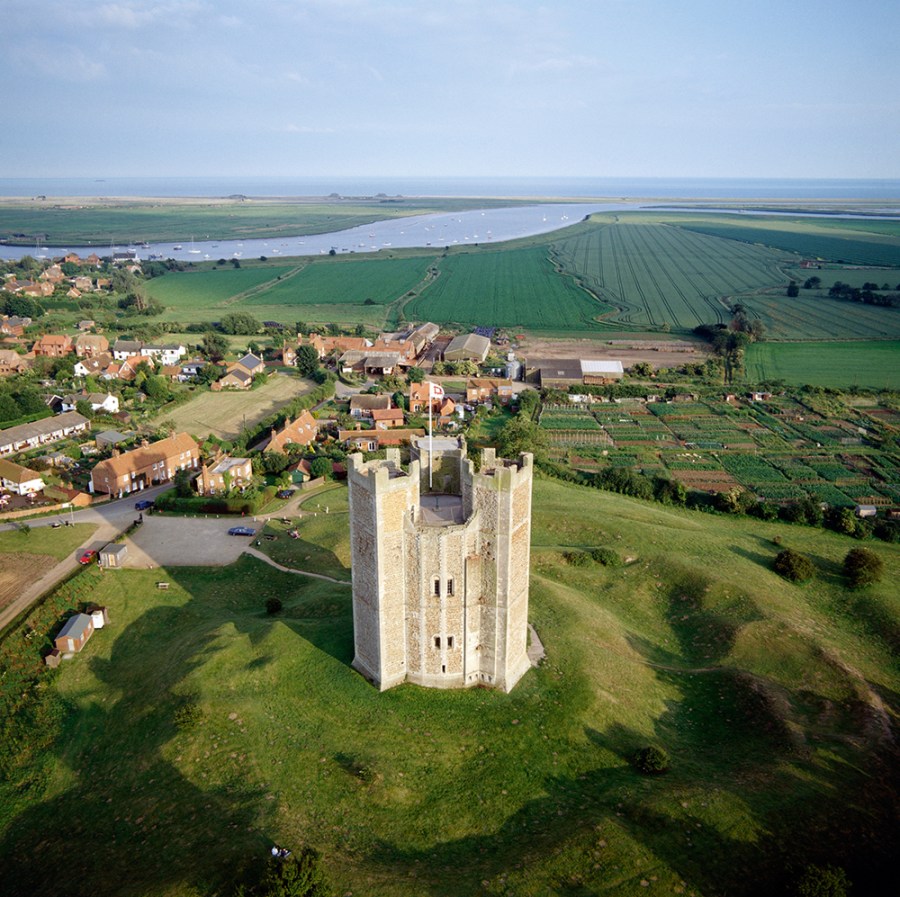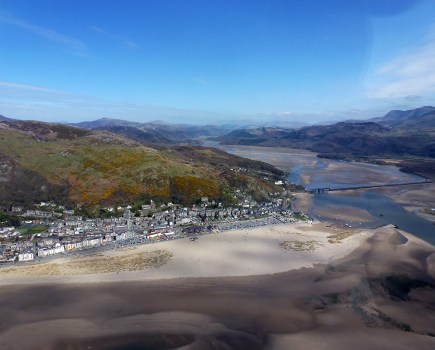SUSIE KEARLEY visits a fascinating deserted island on the Suffolk coast, Orford Ness.
Orford Ness is a large shingle spit in Suffolk, mostly cut off from the mainland by the River Alde. It used to be a military base but today it’s owned by the National Trust and is open to visitors from Easter to October. It’s a fascinating place to visit because of its secret history, remarkable wildlife, and unusual military buildings.
Between 1913 and 1973 Orford Ness was a top secret military research facility operated by the War Department..
In 1962, the War Department land was sold to the UK Atomic Energy Authority. Testing began on the components for atomic bombs to improve targeting and measure the environmental impact of radiation. They also used the Ness as a research hub for radar defence and navigation.
In 1954 the beach was leased to the RSPB and became a nature reserve. In 1971, the Natural Environment Research Council purchased the site to preserve it as a nature reserve. The same year, the Ministry of Defence took over the weapons testing buildings. The RAF bomb disposal squad stayed on site until 1987 – they were the last to leave.
CATCH THE FERRY
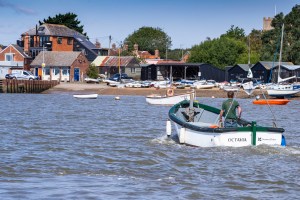
National Trust ferry operating between the mainland and the Island at Orford Ness National Nature Reserve, Suffolk 1526935 NTPL Commissioned (NTPL) ©National Trust Images/Chris Lacey
In 1993, Orford Ness was purchased by the National Trust and today it’s open to visitors at weekends from April to October, with extra open days in July and August. Visitors catch the ferry from Orford Quay to Orford Ness, where a truly unique nature reserve is found alongside fascinating military remains.
As you disembark from the ferry, long grasses and streams line the path to an old MoD hut containing an exhibition. Inside, you’ll learn about the wildlife, military history, and its 18th century use for animal grazing, fishing, and smuggling. The exhibition explores the lives of people who lived and worked on Orford Ness in the early 20th century, before the military took over and the research staff moved in.
RARE SIGHTS
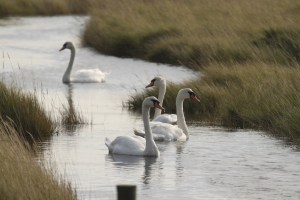
Mute Swans 1200622 Wildlife Project ©National Trust Images / Andrew Capell
The nature reserve on Orford Ness provides a range of different habitats for wildlife, with wetlands, reedbeds and a shingle beach. Wading birds and rare species have made it their home, and you might see oyster catchers, lapwings, little terns, marsh harriers or bearded tits. Its remote location means there are few visitors, making it an attractive environment for wildlife.
Oyster catchers sometimes nest near the ferry point and on one occasion when I visited, there was a worried mother bird trying to shoo us all away, noisily. The staff assured us this had happened before and the young survived, despite the presence of unwelcome visitors. Due to ground nesting birds, some of the footpaths are closed to visitors in the spring.
SECRET SPOT
The Black Beacon, designed to house an experimental rotating loop navigation beacon for military aircraft, today houses an exhibition about the top secret activities at Orford Ness, including a 1970s radar project called Cobra Mist. It was so secret that the military pretended it was just part of the ionospheric radio research station located there.
Cobra Mist was a cooperation between the UK and the USA during the Cold War, with a long range surveillance radar over Eastern Europe. Its purpose was to monitor behind the iron curtain to track aircraft, missiles and satellite launches. A Cobra Mist building was constructed in the late 1960s, but the project was plagued by unidentifiable noise and interference problems, so it was shut down in 1973.
TESTING TIMES
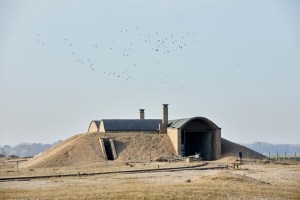
Lab 1 on the A.W.R.E site at Orford Ness National Nature Reserve, Suffolk 1641497 NTPL Commissioned (NTPL) ©National Trust Images/Arnhel de Serra
After the Second World War, British defence turned to the development of new weaponry. At the height of the Cold War, in the 1950s, specialist facilities were created to develop the atomic bomb. The Atomic Weapons Research Establishment and the Royal Aircraft Establishment started developmental work at Orford Ness.
They focused on recording the flight path of the weapon initially, and were monitoring the electronics during flight, but there were also tests to see how the bomb would react in different conditions.
A high explosive initiator could have caused a huge explosion on the Ness, despite the absence of nuclear material. So huge laboratory test buildings were constructed between 1953 and 1966 to absorb the impact of an accidental blast.
Today you can visit one of the derelict bomb testing laboratories. This is where the practical effectiveness of atomic bombs was proven before ‘live tests’ were carried out in Australia. Atomic weapons (minus the fissile core), and their component parts, were subjected to trials, designed to imitate the rigours that a real bomb might be subjected to before reaching its target. Vigorous vibration, sudden drops, shocks, G forces, and extreme temperatures were some of the test conditions monitored by sensors inside.
In the event of an accidental explosion, the thick concrete walls were designed to withstand the impact of a blast. The lightweight roof was designed to blow off, sending heat and shrapnel skywards to protect the workforce on the ground. A later pagoda design was designed so the roof would absorb an accidental blast and deflect it downward.
EXPERIMENTAL SITE
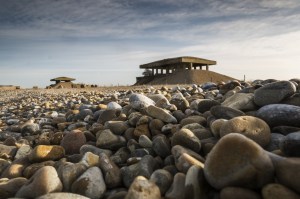
Pagodas at Orford Ness National Nature Reserve, Suffolk. 992930 NTPL Commissioned (NTPL) ©National Trust Images/John Millar
The pagodas have become an iconic feature of Orford Ness and its military testing history. Throughout the 1960s, partially buried concrete structures safely held the weapons that were being subjected to tests.
The Atomic Weapons Research Establishment ceased work on the site in 1971. That’s when the RAF Explosive Ordnance Disposal team moved in and destroyed a lot of the weapons, creating a lot of noise in the process.
The last employee of the bomb disposal squad left in 1987, and Orford Ness became a something of a curiosity, attracting vandals and curious folk. It was closed to the public, but occasionally new equipment would still be trialled there. Today, Orford Ness is the only atomic bomb test site open to the public.
ALL AROUND THE WORLD
After the Cobra Mist project failed, the radar station was transformed into a radio transmitting station and in 1975, the Foreign and Commonwealth Office’s Communications Engineering Department (then called the Diplomatic Wireless Service) moved into the building.
This was followed by the BBC World Service, who moved all their transmissions to Orford Ness between 1978 and 1982. The radio transmissions continued until March 2011. The last transmission was a 24-hour broadcast by Radio Netherlands, to say goodbye to listeners, on May 10-11, 2012, marking the end of its Dutch service. The site closed after that transmission.
In August 2015 a new telecommunications company bought the site, calling themselves Cobra Mist Limited, after the military project. They have been broadcasting Radio Caroline since 2017.
EARLY DAYS
In 1601 a large part of Orford Ness was owned by Sir Michael Stanhope, who owned the Manor of Studbourne and the Manor of Orford. The land was used for fishing, gathering eggs, and grazing. The animals were taken along a road through Slaughden to the Ness – the road has since been lost to the sea. There were several dwellings on the Ness, occupied by labourers.
Orford was a trading port, but as the shingle spit got bigger, it became more difficult for vessels to gain access to the town. Nonetheless, some trading ships continued to use Orford Quay right into the 20th century.
There was a great storm in 1627 when 32 ships were wrecked off Orford Ness. The disaster triggered a debate about the erection of a lighthouse, but it was another ten years before they could agree on what should be done. In 1637 permission was granted to build two lighthouses. The structures were erected, but plagued by problems, including fires and storm damage. One storm in 1887 caused so much damage that the lighthouse was abandoned to the sea.
In the 1700s Orford became a smuggler’s haven. It was closer to the mouth of the river than Aldeburgh, where the custom house stood. The smuggling was known locally as ‘free trade’ and staff from wealthy households often took illicit goods to major towns for sale. In 1714, a massive amount of concealed cargo from a packet ship was seized – it contained brandy, spirits, nutmeg, cloves, almond, silk and other textiles.
IN DEFENCE
Orford Ness was in a prominent defensive position during Britain’s naval wars with the Dutch and the French. Martello Towers were erected along the coast. One Napoleonic tower still stands at the foot of Orford Ness Peninsula today.
THE WORLD WARS
After the First World War the pioneering work continued, testing guns and bombs. The bombing range became known as the most established ballistics testing facility in the UK. Experimental radio beacons and radar development began.
During the Second World War, the airfield moved to Wiltshire, but the experimental work on defence continued. Firing trials helped determine how vulnerable aircraft were to attack. Aircraft and munitions designs were improved, and the work conducted on the Ness saved many lives.
After the war ended, trials continued, looking at the lethality and vulnerability of aircraft and also developing ammunition with good aerodynamics. The testing involved firing rockets with jets into the King’s Marsh. Later on, the Ness became home to the Cobra Mist radar project.
TO THE LIGHTHOUSE
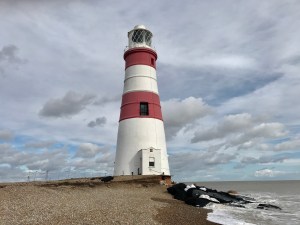
Credit: Lighthouse Trust
The most recent Orfordness Lighthouse was erected in 1792 and served for 228 years, becoming a visitor attraction and a major landmark. Two lighthouse keepers worked shifts, operating the lighthouse manually and living with their families in cottages attached to the tower. They alerted passing ships to threats using the flashing light, the intermittent blast of the fog signal, and a warning cone to warn of an imminent storm.
The lighthouse was electrified in 1959. It was the first lighthouse to be monitored remotely from Harwich in 1964, and became unmanned in 1965. The success of remote monitoring at Orford Ness led to lighthouses being automated across the UK. The keepers’ cottages were demolished in 1959 and 1965.
The lighthouse was eventually decommissioned on 27 June 2013 and the light at nearby Southwold Lighthouse was made brighter to compensate.
The National Trust owned Orford Ness by this time, so they decided to offer guided tours of the lighthouse to people visiting for the day. However problems began to emerge in October 2019 when a bungalow beside the lighthouse collapsed in a violent storm, followed by further storm damage in February 2020. Guided tours were stopped, as the site was unsafe, and in August 2020, the lighthouse was safely deconstructed.
Few of the attractions on Orford Ness today have the visual appeal of Orfordness Lighthouse, which stood proud for hundreds of years, with its red and white stripes visible from afar. It is missed by lighthouse enthusiasts, visitors, and locals alike.
END OF AN ERA
To mark the end of an era, Orfordness Lighthouse Trust issued a statement saying: “Orfordness Lighthouse has been used as a location for concerts, music videos, student films, television documentaries and even a few proposals of marriage. We have had great fun sharing the building and the history of the lighthouse with you and we know it has brought interest and a lot of joy to many people.”
During the demolition work the Trust focussed on the preservation of artefacts, and how best to preserve the memory of the lighthouse after it’s gone. They removed the Lantern Room from the top of the Lighthouse to preserve it and hope that in due course it will form the basis of a lighthouse memorial.
KING’S CAPTURED CASTLE
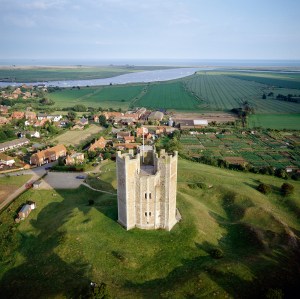
Credit: English Heritage
Back on the mainland, Orford Castle is open to the public. It was built by King Henry II 800 years ago. When he became King he had fewer castles than the Barons, and appeared to hold less power than them, so he took seven castles from Barons who’d displeased him, and built another at Orford.
Inside the keep you can see the great hall, two kitchens, and the chapel, which would have been beautifully decorated in its heyday. Today it’s stripped back to stone, but you can still see the old stone basin where they washed the communion cup. Spiral stairs lead to the priest’s bedroom, King Henry’s bedroom, and the guest rooms which would have been decorated with rich tapestries.
For more info, please visit www.nationaltrust.org.uk

